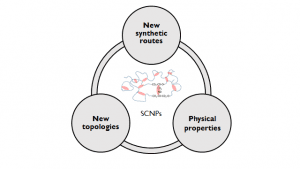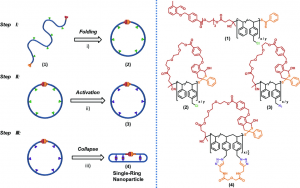PhD Thesis Defense- Jon Rubio
 New Synthetic Routes, Topologies and Physical Properties of Single-Chain Nanoparticles
New Synthetic Routes, Topologies and Physical Properties of Single-Chain Nanoparticles
Candidate: Jon Rubio Cervilla
Supervisor: Josetxo Pomposo
Research group: Polymers and Soft Matter Group
When: April 3 (11:30h)
Where: CFM Auditorium
Summary

The thesis is focused on the study of Single-Chain Nanoparticles (SCNPs)
This thesis presents and in-depth study of polymeric single-chain nanoparticles (SCNPs). The combination of state-of-the-art polymer synthesis and advanced characterization techniques will allow us to:
- Establish new synthetic routes towards SCNPs.
- Synthesize SCNPs with novel topologies.
- Carry out a thorough study of the physical properties of SCNPs.
Chapters 1 and 2 introduce this emerging field and review the fundamental concepts, current synthetic methods, potential applications and some of the most widely used experimental techniques. Instrument types and setups used for this work are summarized in Chapter 2.

Applying Single-Chain Technology to construct novel soft nano-objects
Chapter 3 presents an unprecedented merging of zwitterionic ring-opening polymerization and photoactivated thiol-yne coupling, resulting in an interesting new pathway towards SCNPs. Advanced techniques including, among others, in situ 13C nuclear magnetic resonance (NMR) measurements or Mark-Houwink-Sakurada plots are employed to gain insight into the polymerization and SCNP formation processes.
In Chapter 4, a new SCNP topology is targeted: the single-ring nanoparticle (SRNP). It is finally achieved by a combination of controlled radical polymerization, photoactivated hetero Diels-Alder reactions and copper-catalyzed click chemistry. The resulting SCNPs are thoroughly characterized by size exclusion chromatography, nuclear magnetic resonance, infrared spectroscopy and UV-Visible spectroscopy.
Chapter 5 comprises a quantitative study of the size reduction upon reversible SCNP formation. Following a Flory-like argument, we propose an expression that provides a priori estimation of the size reduction upon folding single-chains. We perform a comparison of the predicted size reduction with extensive literature data (72 SCNPs, 22 reversible interactions).
To conclude, Chapter 6 presents a novel method to synthesize totally deuterated SCNPs starting from commercially available monomers and initiators. An exhaustive study of the structural and dynamical properties of these SCNP melts is also performed, combining a variety of techniques, including elastic and quasi-elastic neutron scattering, dielectric spectroscopy, rheological measurements and calorimetries.




 New Synthetic Routes, Topologies and Physical Properties of Single-Chain Nanoparticles
New Synthetic Routes, Topologies and Physical Properties of Single-Chain Nanoparticles